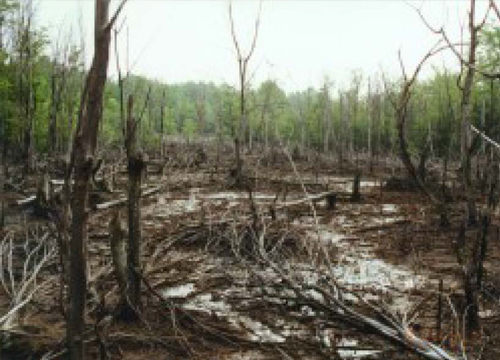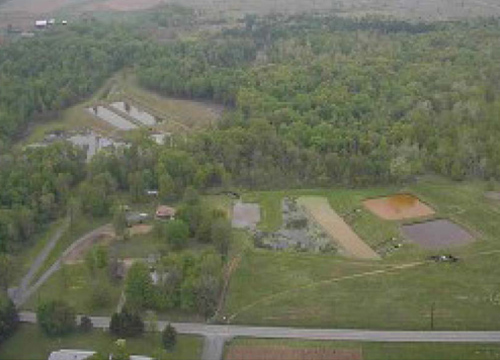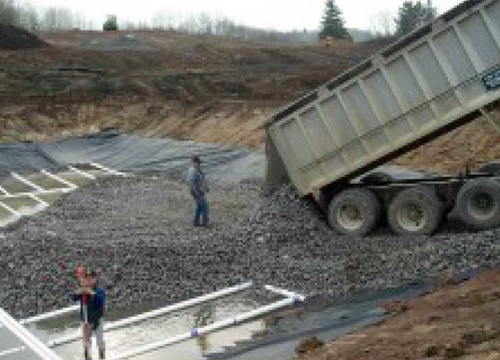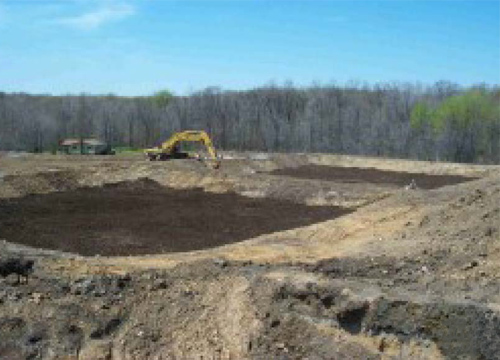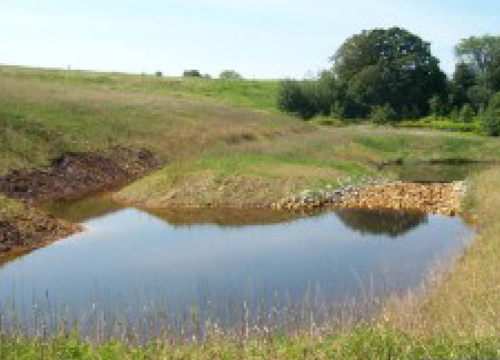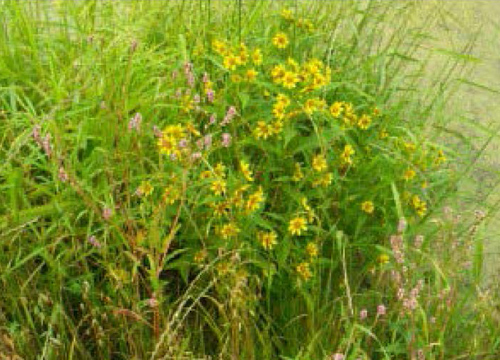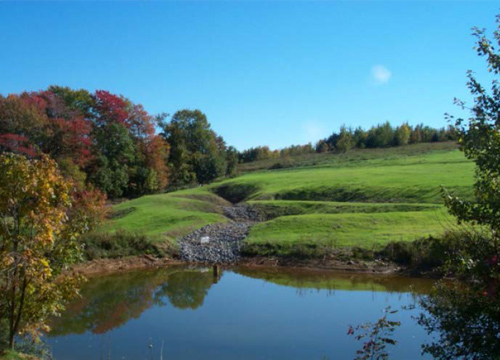Green Remediation Focus
De Sale Restoration Area
Butler County, Pennsylvania
PA Voluntary Cleanup
Cleanup Objectives: Treat acid mine drainage (AMD) from abandoned coal mines to restore water quality and aquatic life in Seaton Creek. The De Sale Restoration Area, located in the 10.4-square mile Seaton Creek watershed, had been heavily impacted by over 100 years of surface and underground bituminous coal mining. Seaton Creek is a major tributary in the headwaters of the 408-square mile Slippery Rock Creek watershed in the Ohio River Basin. The Slippery Rock Creek headwaters were selected as one of the areas to be evaluated under the Pennsylvania Comprehensive Mine Reclamation Strategy, and in 1994 a public-private partnership was created to reclaim abandoned mine lands and address the impacts of AMD.
In the uppermost Seaton Creek headwaters, remediation actions have included installing three passive treatment systems and reclaiming about 85 acres of impaired land in the watershed. The treatment systems, known as De Sale Phases 1 and 2 (continuously online since 2000) and De Sale Phase 3 (continuously online since 2003), each address a separate tributary. AMD to be treated at De Sale Phases 1, 2 and 3 is intercepted and diverted to multiple passive treatment components that include forebays, flushable vertical-flow ponds, settling ponds, free-flowing constructed wetlands and horizontal-flow limestone beds.
Green Remediation Strategy: Treatment of the AMD discharges involves implementing the following best management practices (BMPs):
- Designing passive treatment systems and mine-land reclamation projects situated within mining-impacted areas in order to protect environmentally-significant features, such as forested wetlands.
- Relying on gravity flow rather than pumps, avoiding possible air emissions, to convey AMD to settling ponds, vertical-flow ponds, constructed wetlands and horizontal-flow limestone beds comprising the treatment systems.
- Vegetating constructed wetlands for use as a "nursery" in order to supply plants, cuttings and seeds for future treatment wetlands at other nearby AMD sites.
- Utilizing select onsite mine soil as a growth medium (topsoil) and appropriate onsite earth materials for embankment construction, rather than excavating and transporting materials from offsite sources.
- Choosing treatment and reclamation materials that are byproducts from other industrial sectors, such as agricultural compost and coal ash from a nearby power plant that generates electricity from waste coal.
- Reusing construction materials and repurposing existing onsite treatment components.
- Re-vegetating with state-approved seed mixtures and with tree seedlings or live stakes that do not require irrigation.
- Recovering waste from AMD treatment such as manganese and iron oxides for potential commercial use.
- Maximizing use of field test kits for ongoing water quality screening and monitoring.
- Engaging community members such as local volunteers, students, mining companies, engineering firms, academic institutions, and local, state and federal government agencies in the remediation process to assure the project complements anticipated reuse of AMD-impacted areas. The volunteer Slippery Rock Watershed Coalition, which is sponsored by the non-profit Stream Restoration Inc. coordinates the design, construction and monitoring of the AMD treatment systems.
Results:
Energy & Air
- Avoiding consumption (and associated costs) of fossil fuel-derived energy needed to power an active treatment system relying on pumps to collect and treat the AMD.
- Avoiding onsite or offsite air emissions associated with transporting diesel or gasoline to power pumps to collect and treat AMD.
- Avoiding fuel use and air emissions associated with transporting routine water quality samples to offsite laboratories by using field meters and test kits for pH, alkalinity, dissolved oxygen and iron.
- Decreasing fuel consumption and associated air emissions through the reduced frequency of site inspections and monitoring required for passive versus active treatment systems.
- Decreasing fuel consumption by enlisting adjacent landowners to inspect and report site conditions.
- Avoiding fuel consumption and associated air emissions through use of materials obtained onsite or from nearby sources, such as onsite mine soil, limestone aggregate from a quarry located about 6 miles away, and compost materials from a farm about 30 miles away.
Material Use & Waste Reduction
- Using about 2,100 cubic yards of spent mushroom compost, consisting largely of waste materials (horse and chicken manure, hay and straw), rather than virgin or manufactured products, and gypsum.
- Avoiding the need for fresh topsoil by using onsite mine soil as substrate for constructed wetlands.
- Using 500,000 tons of alkaline fluidized-bed coal ash, a byproduct from the nearby Scrubgrass Generating Plant, to stabilize and reclaim about 85 acres of impaired mine lands contributing to AMD.
- Recovering manganese and iron removed as oxides by the passive treatment systems for use by local and regional ceramic artists. Proceeds from sale of the pottery are placed in dedicated funds for future activities to maintain the treatment systems.
- Vegetating the wetlands with select native plants from nearby State Game Lands 95 at no cost through a public-private partnership with the Pennsylvania Game Commission.
- Reused ponds constructed as part of a former AMD chemical treatment system as components of the De Sale Phase 3 passive treatment system, rather than constructing new ones.
- Reusing Jersey barriers obtained from a passive treatment system elsewhere in the Slippery Rock Creek Watershed to protect a constructed treatment wetland and access road at the De Sale Restoration Area.
- Removing metal-bearing solids accumulated in the limestone aggregate and spent mushroom compost approximately every 10 years to sustain treatment performance, rather than replacing the treatment media.
Water, Land and Ecosystem Service Protection
- Neutralizing approximately 142,000 pounds of acidity per year from the AMD affecting surface water quality, and achieving greater than 90% reductions of iron and aluminum concentrations and about 50% reduction of manganese concentrations in treated water.
- Returning treated water to its natural hydraulic course, the tributaries in the headwaters of the Slippery Rock Creek Watershed. The three De Sale systems treat an estimated combined flow of 130 million gallons per year.
- Restoring populations of fish, including pan fish, large-mouth bass and catfish, to Seaton Creek after a 70-year absence.
- Created about 2 acres of new wetlands populated by native and non-invasive plant species to offer optimal wildlife habitat.
- Returning mining-impaired land to productive use such as wildlife habitat and recreational opportunities by reclaiming barren spoil piles, open pits, sludge ponds and kill zones.
- Regrading reclaimed land to approximate the original pre-mining contours and revegetating the land to help decrease AMD flow, increase alkalinity, and lower metal concentrations.
- Engaged numerous volunteers and organizations in installing, monitoring and maintaining the AMD passive treatment systems as well as the adjacent land reclamation projects. Assistance was provided by more than 10 mining-related companies and engineering firms; 10 landowners; 10 local, state and federal government agencies; six academic institutions; and five non-profit organizations.
Property End Use: Natural resource restoration area under state programs that is also used for research by local and regional colleges and universities, non-profit organizations and government agencies, including the Smithsonian Institution and U.S. Department of Energy.
Point of Contact: Margaret Dunn, Slippery Rock Watershed Coalition; John Stefanko, Pennsylvania Department of Environmental Protection
Update: April 2016


